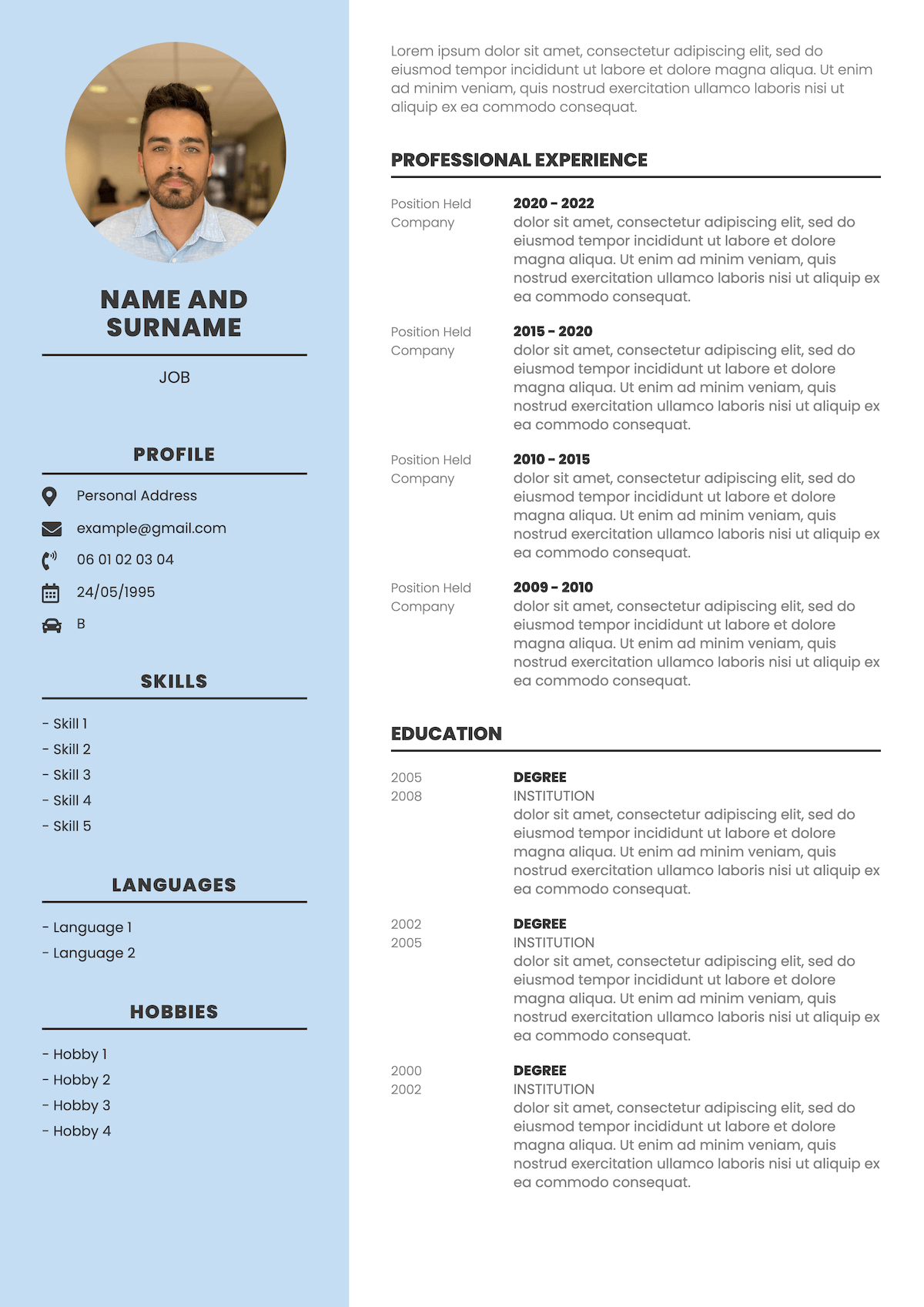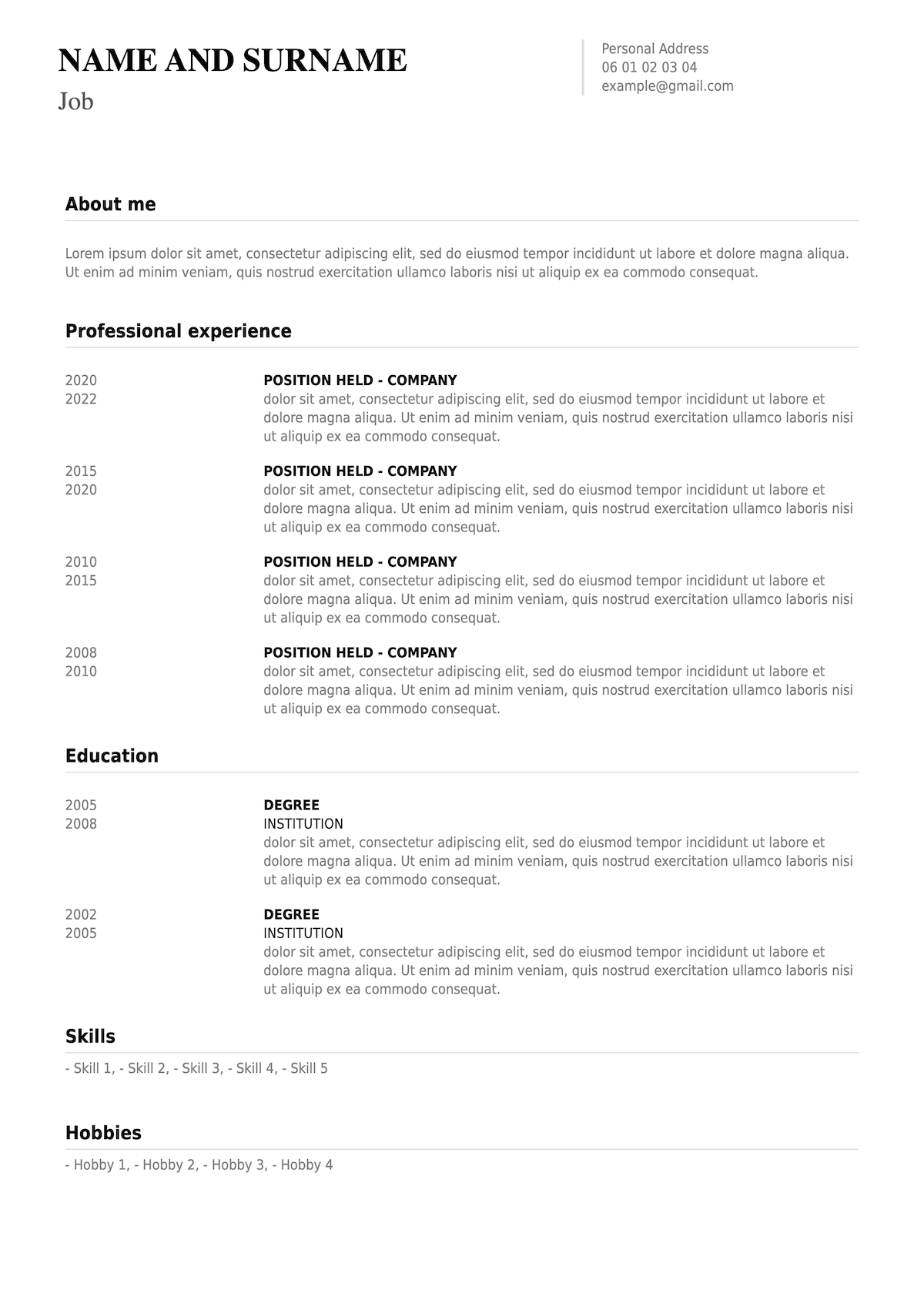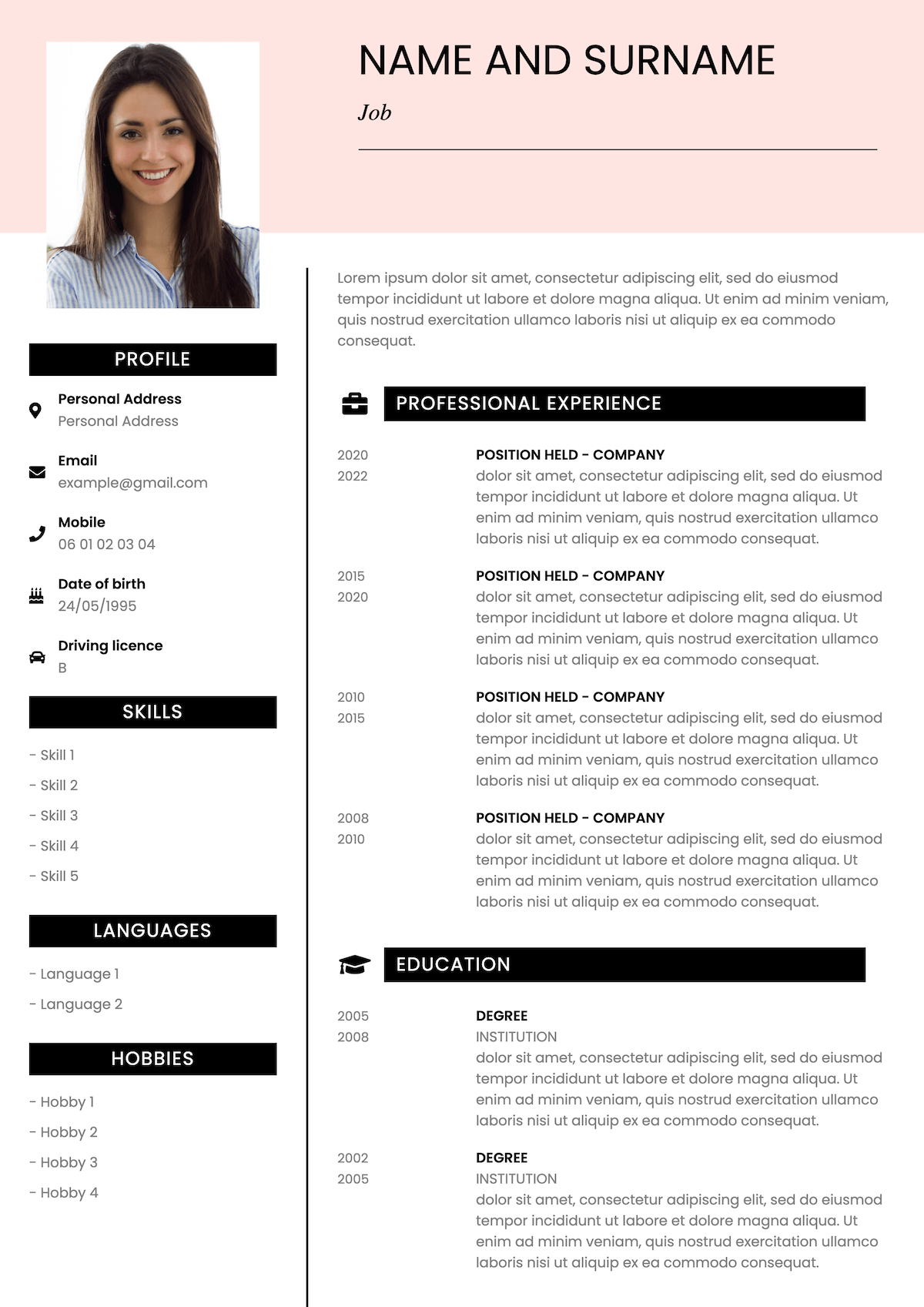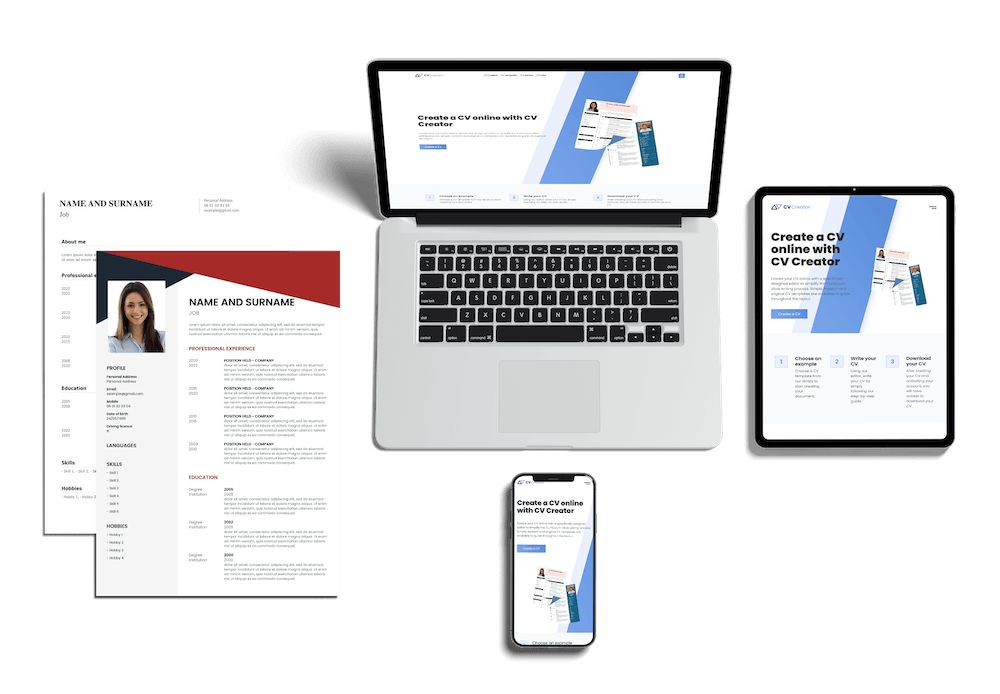CV type
Which CV type to use for your CV? So many conflicting viewpoints, which one is best for you? Follow our expert step-by-step guide to find out which CV type will get you hired.
Create your CV now
Choose a template CV and create your own online
Want to see more CV templates?

You are ready to write your CV. But which CV type to use? Or is it CV format? Or was it CV layout?
It’s very easy to get mixed up if you don’t know the jargon.
So the big question is, which CV type will get me the most interviews?
That’s where we come in. It’s all under control. You’re going to learn to choose which CV is right for you based on your prior experience. Our advice and tips will show you how to use the CV type to its full potential.
In this guide, you will learn about the following :
- Functional CV (Examples and Pro Tips)
- Chronological CV
- Combined CV (Examples and Pro Tips)
In a rush to build your CV? Don’t have time to go through the entire blog and need a great CV in 5 minutes? Give our CV Creator a go. With more than 20 ready to use tailored CV to choose from, you will be spoilt for choice.
So if you are short of time, you can create your CV here.
Functional CV Type
The functional CV, otherwise known as the skills based CV, has a strong focus on skills. It is commonly used by those seeking a career change. Unlike a chronological CV which is focused on your work experience in reverse chronological order.
Not commonly loved by recruiters and managers, it can also be used by candidates desiring a senior or executive role. Such job applications may need a functional CV with a chronological CV beside it.
Before we start, regardless of the CV Type you have chosen, it is widely advised to follow the comprehensive how to write a CV guide. Step by step, section by section, it will guide you all the way to create the perfect CV for you.
How to Write a Functional CV
Here is how to create a great CV structure that will impress hiring managers. This type of CV can be used by all types of candidates.
Add Contact Details
Put your full name and personal details in the top left corner of your CV. Do not repeat this process on other pages if your CV is longer than one A4 page. Insert a professional email address besides a contact number. Make sure your contact number is valid in the country you are seeking employment.
Pro Tip: Show you are keeping up to date with current trends by including a QR Code for your LinkedIn profile. Recruiters appreciate this as it makes it easier for them to view your credentials.
If you are unsure how to write a CV, you can click here for more expert guidance.
Insert a Personal Statement
Add a Personal Statement underneath your contact details. A personal profile is a 4 to 5 sentence paragraph explaining your skills, ambitions and visions.
Many recruiters in the UK will not read a CV without one. Unimpressed by your statement, they will not continue to read the rest of the functional CV. If you are not submitting a Cover Letter beside your CV, this statement carries added importance.
If you need further help to write a great personal statement, please click here.
Pro Tip : Use your cover letter to strengthen your personal statement. Show your skills and capabilities in greater depth. Showcase why you should be viewed as a strong candidate for the role. It will help reassure the recruiter on any doubts he may have about your CV .
Input your Skills
Adding your skills to your CV is crucial. This is the most important part of your CV. Focus on the job advert you have chosen. Underline the keywords used by the employer.
These are the skills they require and need from a candidate. As each CV is tailored for the advert, your skills should center around those needs.
Two main types of skills exist. Hard skills and soft skills. Hard skills are acquired through experience. They are also referred to as practical skills. Soft skills are experienced and learnt through social interaction. It is much easier to quantify hard skills. Remember, employers like numbers and tangible results.
Choose between six to eight skills for your CV. It is the core of your CV so make sure these are skills you are comfortable with. Explain each skill with bullet points and examples.
Pro Tip: Organise your skills according to a specific theme. For example, list a group of skills under “Data Analysis” or “Web Developer”.
This will make it clearer for the recruiter to understand if you are the right person for the role. This can especially help you if the rest of your Functional CV is unrelated to the job advert.
Enter your Academic Achievements
Begin with your most recent completed qualifications. Use the same process as in the chronological CV.
Start with your latest degree and work backwards. Make sure to the full name of the degree, the University and the core module you took. Enlist all modules and grades which can impact in a positive manner your application.
Pro Tip: Add projects you may have carried out whilst at university. This is a great way to show your drive to get results.
Add Work Experience to your Functional CV
Insert your work experience last. This is the last main section of your CV. It will not be considered in great detail by the recruiter if you have explained your skills.
List all relevant work experience or volunteer work you may have carried out.
Key Points for a Functional CV
Here are the key points for you to take away for your CV. These will make sure you are successful in your applications:
- Explain your Skills in great detail. A functional CV is focused around your skills, not your past work experience.
- List your skills as themes. A great way to organise your skills is through themes. This makes it easier for the hiring manager.
- Match the keywords of the job advert with the skills you put forward.
- Insert your work experience as the last section of your CV.
- Proofread your CV and Cover Letter before sending the application.
If you are still unsure how to write your CV or need further guidance, please do not hesitate to contact us here.
Chronological CV Type
The most widely used of all CV types, the chronological CV is very popular with all candidates. It provides all essential information about your work experience, listed in reverse chronological order. This type of CV is suited for those with a few years of experience. It can also be applied by graduates who apply the same methodology with their academic achievements.
If you would like to follow a full guide on the Chronological CV, please click here.
Combination CV Type
A Combination CV, unlike the other CV types, is a hybrid between the functional and chronological CV. It combines aspects from both. It is best suited for candidates who want to showcase their skills just as much as their experience and education.
As a more detailed version, it’s a great way template for those in need of a career change or to explain gaps.
Put simply, if you have recently changed job roles for a completely different industry, you can use this CV type to emphasize your skills rather than explain your career change. More and more job hoppers are becoming the norm, chasing greater pay and benefits.
How to Write a Combination CV
Here is how to create a great CV structure that will impress hiring managers. This type of CV can be used by all types of candidates.
Give your personal contact details
Provide your first name and last name. Ensure an appropriate font is used so the recruiter can read it properly. Add other contact details such as your professional telephone number and email address.
Only insert your personal address if requested. Finally, you can also input your LinkedIn profile as a further way of contacting you.
Pro Tip: Impress hiring managers by including a QR Code for your LinkedIn profile. This will show you are staying up to date with current trends. Furthermore, add a quote from a well-respected individual whose values you share and seek to emulate.
Include a Personal Statement
Add your personal statement below your contact details. Your personal profile should consist of 4 to 5 sentences. It is a very important statement for UK recruiters. It sets out your past achievements, your transferable skills and what you wish to achieve with a company.
Take the time necessary to write a great personal statement. If you are not providing a Cover Letter with your CV, the personal profile carries even more weight.
Pro Tip: Show you have done your research by inputting keywords in your personal profile. Take the job advert you are applying for. Underline all the keywords in the ad. Find scenarios where you have demonstrated these skills in your career or education. It will also help you pass the ATS (Applicant Tracking System) software commonly used by managers.
This will impress recruiters as it shows you understand their needs.
Emphasise your Skills and Qualifications
Enlist your key skills, education and work experience. Ensure to make a segment for each of these. Start with the most important section and finish with the least important. If you have just graduated, your skills or education section should come first.
Just as vital as your personal statement, skills paragraphs centered around job keywords will be greatly rewarded.
Pro Tip: Do not list all your skills and experiences on your CV. It is important to tailor your CV to the job advert. Not the other way.
Key Points for your Combination CV
Here are the key points for you to take away for your CV. These will make sure you are successful in your applications:
- Combine your relevant skills and experience to create a Combination CV. It provides a great structure for those seeking a career change or have employment gaps.
- Increases your prospects if you have strong relevant work experience.
- Allows you to list your key strengths and work experience.
- Use a Combination CV only if you have experience. If you lack experience or education, you need a different type of CV.
There you have it. All the tools you need to go out and create a winning CV and land your dream job!
If you are still unsure how to write your CV or need further guidance, please do not hesitate to contact us here.





